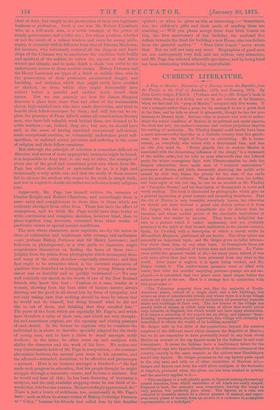CURRENT LITERATURE.
A Peep at Mexico: Narrative of a Journey across the Republic from the Pacific to the Gulf in December, 1873, and January, 1874. By
John Lewis Geiger, F.R.G.S. (Tx-iibner and Co.)—Mr. Geiger's book is rather thin, though it is bulky, but we do not wonder at its thinness,. when we find that his "peep at Mexico" occupied only five weeks. It was a scamper rather than a peep, for he managed to see a great deal in the time, and he tells us about it pleasantly, though he has few pre- tensions to literary style. Serious value to readers who wish to under- stand the actual condition of Mexico, in its political and social aspects,. the book has not ; the author's extreme and violent prejudices deprive his writing of authority. Mr. Whalley himself could hardly have been a more untrustworthy traveller in a Catholic country than this gentle- man, who sees the blight of Popery on everything. He is incon- sistent, as everybody who writes with a determined bias, and has an idle fixe, must be. "Every ghastly blot on modern Mexico is associated with the devastating influence of the clergy" is a statement of the milder order, but he tells us soon afterwards that the Liberal party, for whose courageous fight with Ultramontanism he feels the deepest admiration, have made men of " criminal antecedents governors of States, and while decorously deploring the public evils caused by civil war, blame the priests for the state of the roads- and the prevalence of robbery. When he dismounts from his hobby,. and loses sight of the red rag, he can be as sensible as Mr. Whalley- on "Turnpike Trusts," and his description of Guanajuato is novel and worth reading. The book is illustrated by photographs which give us a general impression of great extents and exceeding dreariness. That the city of Mexico is very beautiful everybody knows, but otherwise we should not have derived a grand and stately notion of it from Mr. Geiger, who has a more sympathetic eye for defects than for beauties, and whose cordial praise of the charitable institutions at Leon takes the reader by surprise. They form a delightful fea- ture in a picture which is rather unpleasing, and are evidently governed in the spirit of that blessed institution in the parent country, Spain, La Caridad, with a description of which a recent writer in Macmillan's Magazine gladdened all our hearts. The silver mines are naturally an important topic, and Mr. Geiger gives us fuller informa- tion about them than on any other topic. At Guanajuato there are considerably over a hundred, of various sizes and richness. La Valen- ciana yields the greatest wealth of all,—for many years, indeed, it was said, more silver than had ever been procured from any other in the world. After years of neglect, it is again being worked, and Mr.. Geiger visited it. The subterranean passages were so filled with water, that after ten months' emptying process—pumps are not em- ployed—it is calculated that two years more must elapse before the miners can get at the ore. Here is a strange fact in connection with this great mine :— " The Valencian property does not, like the majority of North- American mines, consist of a single shaft and a few buildings, but covers an area of considerable extent, and where there is a large village with an old church, and a number of enclosures, all possessing separate shafts and buildings of their own. The low houses of the village are mostly built of stones, in which lurk veins of silver that would prove very valuable in England, but which would not here repay abstraction- If in future a reduction of the export tax on silver, and cheaper' bane- flciating ' arrangements, should supervene, this village will certainly be demolished to obtain the wealth of its building material."
Mr. Geiger tells us but little of the populations, beyond the relative numbers of the different races which compose the Republic of Mexico ; but we do not remember to have previously found in any book about Mexico an account of the rag figures made by the Indians in and near Guanajuato. It seems the Indians have a traditionary talent for the moulding of rags into figures illustrative of the different costumes of the country, exactly in the same manner as the natives near Guadalajara mould clay figures. Mr. Geiger pronounces the rag figures quite equal to the clay ones, and tells us of other curiosities of Mexican art,— images and figures cast from the solid silver amalgam of the haciendas de beneficio, produced when the silver ore has been crushed to powder and the mercury applied to it :— " This amalgam is .a soft, pliable paste, in Spanish mining phraseology named limadora, from which statuettes of all kinds are easily shaped. Exposed to heat, the mercury soon evaporates, leaving the image in very porous, but perfectly pure silver. The figures, as a rule, are coloured to resemble mature by a clever process of enamel, and repre- sent every phase of society, from an arriero or a carbonero to &complete representation of a bull-fight"
We are glad to learn, incidentally, that except at Guadalajara, where only there is an amphitheatre for bull-fights, the native artists are no furnished with opportunities of studying these atrocious subjects from the hideous life, or rather death.



































 Previous page
Previous page